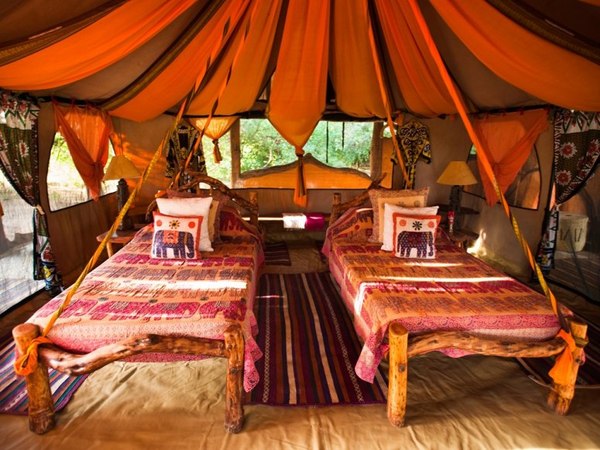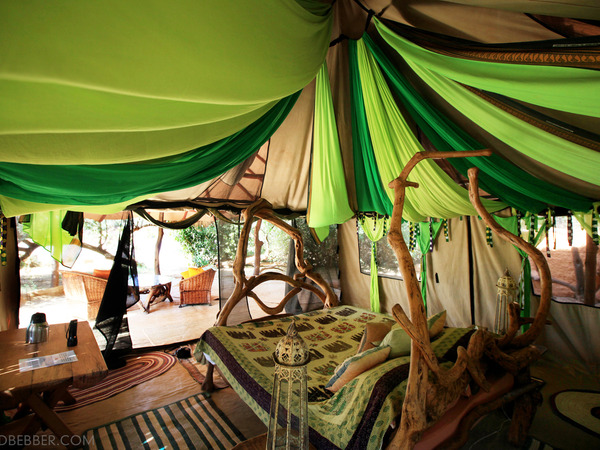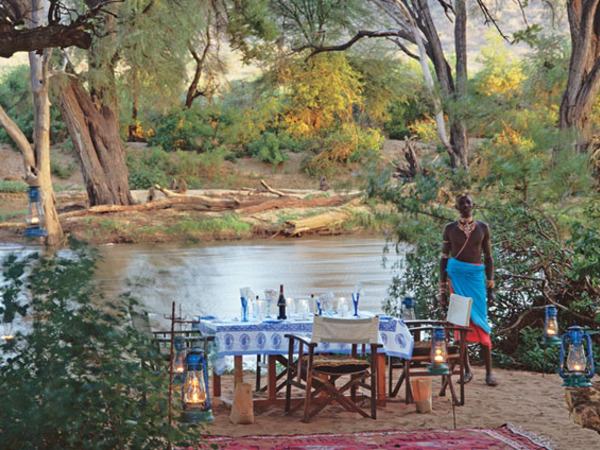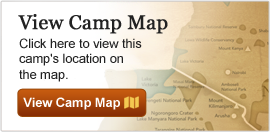Elephant Watch Camp
traditional Camp | Samburu Nat'l Reserve, Kenya
| Read Reviews | Write a Review
This unique camp in Samburu National Reserve is perched on the sandy banks of the Ewaso Nyiro River beneath spreading acacia trees. It is home to some of the largest bull elephants in Africa, which are often spotted mudding in the river, resting in the shade or picking pods from trees beside the tents. An eco-camp in every sense of the word, Elephant Watch epitomizes harmony with its natural surroundings.

Our Expert Says
The foremost elephant researcher in the world is Iain Douglas-Hamilton, and his daughter Saba runs this camp. She's appeared on the BBC, and her love for wildlife, particularly elephants, is apparent when you stay here. There is a book in each vehicle that you can use to identify each individual elephant and learn about its history. If you love elephants, this is the place for you!
– Wendy Klausner

The Camp
Location: Samburu National Reserve, Kenya
Number of Tents: 6
Important Note: Though this camp is Traditional in terms of amenities, it falls into a Premier pricing category because of the unique experience it offers guests.
Eco-friendly Elephant Watch Camp is cleverly constructed of recycled trees and logs. Colorful thatched-roofed tents are designed for maximum coolness, privacy and protection and have their own verandas. Crystal-clear camp water comes from a small village well; there is no running water at camp. Each tent has been specially designed around its own shade trees. Beautiful hand-made basins and painted buckets filled with clean sun-heated water offer guests a novel washing experience, and soft robes are provided for post-bathing comfort. Eco-flush toilets use a minimum amount of water. In the lounge, relax on luxurious sofas and chairs built from twisted acacia branches collected from trees felled by elephants. The campfire and hurricane lamps light up the dinner table, where superb organic food is served. Elephants are never far away, so Samburu warriors escort guests after dark and keep watch throughout the night.

Facilities & Amenities
- En suite bathroom with safari shower
- Tea/coffee in room
- 220v charging outlets in room
- Laundry included
- Local drinks included (house alcoholic and non-alcoholic drinks)
- Credit cards accepted (Visa and MasterCard)
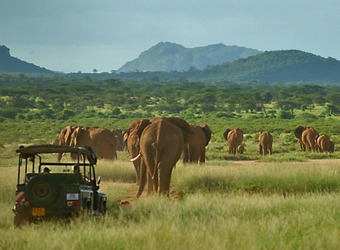
Wildlife Viewing & Activities
Elephant watching begins on arrival. On your game drive from the airfield to camp the guides will introduce you to many of the well-known elephant families. Observing the gentle elephants as they slowly approach is an awe-inspiring experience. From your vehicle you will be surrounded by their sounds, smells and warm breath. Elephants can come very close -- you do not need to fear them -- but follow your guide’s directions and keep the proper distance. Other inhabitants include reticulated giraffe, Grevy’s zebra, Beisa oryx and more than 350 resident birds with an additional 70 migrant species, enjoyed most fully on birding walks. You may also spy lion, cheetah or a leopard in a tree. At night, lions roar and hyenas howl, owls hoot and baboons bark under the black sky with a million stars. As the sun rises, a treetop chorus of birds and monkeys beckons you to a new day in the wild.
The below chart helps to illustrate major wildlife sightings often experienced in Samburu National Reserve. Other typical sightings may include unique subspecies, such as reticulated giraffe, endangered Grevy’s zebra, Somali ostrich and gerenuk as well as jackals, warthogs and a number of other mammals, birds and reptiles. Exact sightings will depend on seasonality and wildlife movements.
| Country | Park/Reserve |
Buffalo
|
Cheetah
|
Eland
|
Elephant
|
Gemsbok / Oryx
|
Giraffe
|
Greater Kudu
|
Hyena
|
Leopard
|
Lion
|
Zebra
|
|
|---|---|---|---|---|---|---|---|---|---|---|---|---|---|
| Kenya | Samburu Nat'l Reserve |
| Usually viewed | Frequently viewed | Occasionally viewed | Sporadically viewed | Rarely to never viewed |
Climate
| Month | Max | Min | Rainfall |
|---|---|---|---|
| January | 86° F | 75° F | 1.06 in |
| 30° C | 23° C | 27 mm | |
| February | 88° F | 75° F | 0.59 in |
| 31° C | 23° C | 15 mm | |
| March | 88° F | 77° F | 2.32 in |
| 31° C | 25° C | 59 mm | |
| April | 86° F | 77° F | 6.97 in |
| 30° C | 25° C | 177 mm | |
| May | 82° F | 73° F | 10.39 in |
| 27° C | 22° C | 264 mm | |
| June | 81° F | 72° F | 3.9 in |
| 27° C | 22° C | 99 mm | |
| July | 79° F | 70° F | 3.11 in |
| 26° C | 21° C | 79 mm | |
| August | 81° F | 70° F | 2.52 in |
| 27° C | 21° C | 64 mm | |
| September | 81° F | 70° F | 2.52 in |
| 27° C | 21° C | 64 mm | |
| October | 82° F | 72° F | 3.5 in |
| 27° C | 22° C | 89 mm | |
| November | 84° F | 73° F | 3.7 in |
| 28° C | 22° C | 94 mm | |
| December | 86° F | 75° F | 2.44 in |
| 30° C | 23° C | 62 mm |
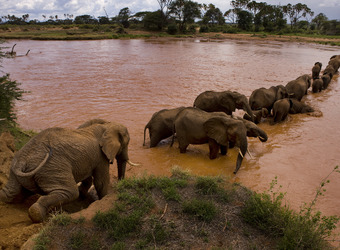
Conservation
As Elephant Watch was conceptualized, the camp’s owner took inspiration from nature. While walking through the forest he saw the towering dead trees stripped bare of their bark by elephants --.these became the long poles for the lodge/tent frames; the twisted branches were used for the walls, and the many other bits of wood were shaped into unique pieces of furniture. The camp would exist as part of the landscape, remaining as close to nature as possible. Elephant Watch Camp was born -- completely eco-friendly with no waste, pollution, generators, garbage, chemicals or water wastage. Elephant Watch has a charcoal cold room, which keeps farm-grown organic fruits and vegetables fresh. Lighting is solar-powered. Coal-filled irons press guests’ laundered clothes. Elephant Watch contributes to Save the Elephants, which supports the continued international ban on ivory trade. Camp staff gather elephant census data and educate and involve local people to stimulate hands-on learning, environmental awareness and foster positive attitudes about conservation.


